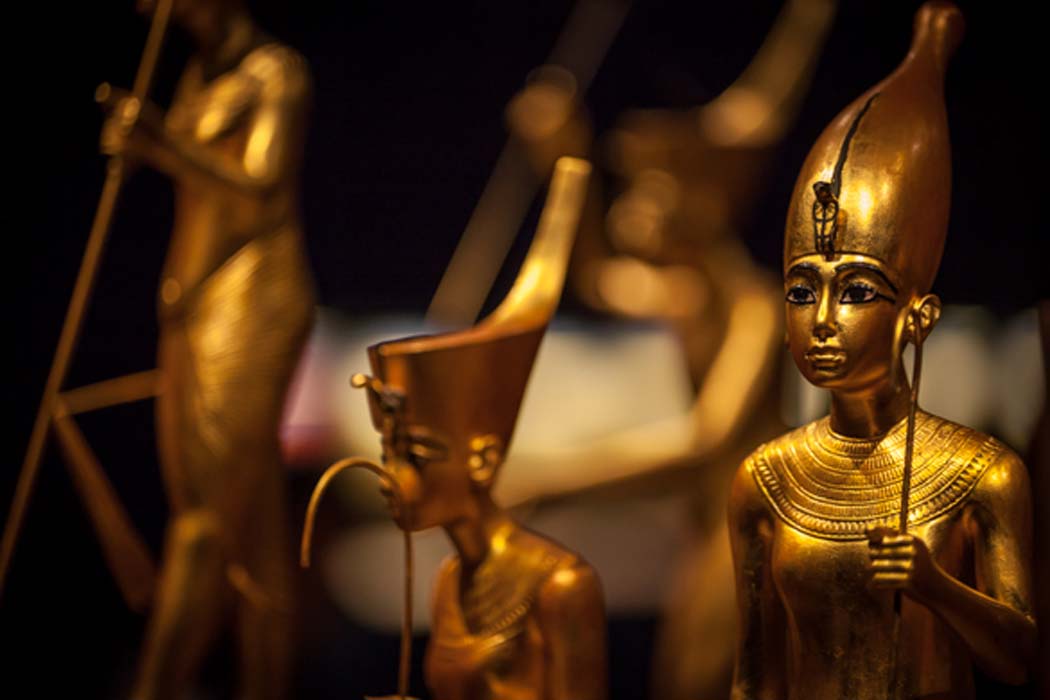To his subjects, King Tutankhamen was part man, part god. His death in 1323 BC signaled the end of an era – the end of Egypt as an imperial power. The circumstances surrounding King Tut’s death are shrouded in mystery. Equally obscure is the reason for his unusually small tomb. And yet, thanks to Howard Carter’s discovery nearly 3,000 years later, there is no Pharaoh more well-known and well-loved than King Tut. Inside the tomb, Carter discovered glorious treasures that had lain undisturbed for thousands of years. For a culture that believed being remembered was the path to eternal life, the preservation of King Tut’s tomb has ensured that his nameless and forgotten enemies failed miserably.
An Astonishing Array of Grave Goods and The Most Intact Royal Tomb Ever Found
Tutankhamen died of unknown causes in 1323 BC at the age of 20. He did not have a clear successor but the tiny mummies of two stillborn daughters, possibly twins were found in his tomb. Due to his sudden and unexpected death, the burial was hastily prepared in a somewhat less-than-grand tomb, measuring only “3.68 m or 12.07 feet high, 7.86 m or 25.78 feet wide and 30.79 m or 101.01 feet long” (History Embalmed, 2016).
For political reasons, the boy-king was to be forgotten and his name never mentioned for the rest of eternity, a fate worse than death for the ancient Egyptians. Yet by a strange stroke of luck, Tut’s obscurity preserved his tomb from grave robbers. Then, “discovered by archaeologist Howard Carter in 1922, the tomb of King Tut yielded an astonishing array of grave goods—more than 5,000 artifacts, many of them in pristine condition. It was the most intact royal tomb ever found, providing Egyptologists with an unprecedented glimpse into the material life of a king who ruled during the 14th century B.C.” (Hessler, 2016).
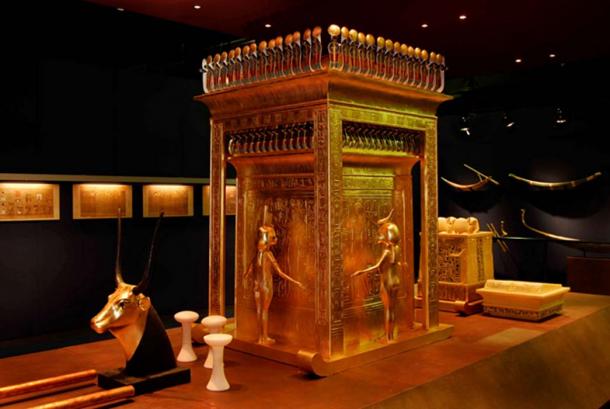
The canopic shrine from King Tutankhamun’s tomb. ( seethrumag.org)

Tutankhamun’s throne from his burial chamber. ( public domain )
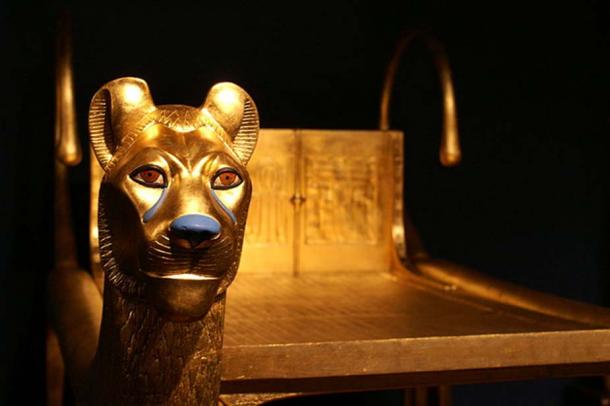
Detail of golden lions on a ritual bed found in the tomb. ( CC by SA 3.0 )
The Golden Sarcophagus
It took Howard Carter 10 years to clear and catalog all the riches stored in the tomb. Most spectacular of all was the golden sarcophagus of Tutankhamen and the inlaid coffins, including one made of solid gold. Inside this nesting-doll-like assembly, rested the mummified body of the boy-King. His death mask, also made of gold, has become the symbol of ancient Egyptian finery and is considered one of the greatest works of art of the ancient world. It was Carter himself who, on October 28, 1925, lifted the heavy lid of the sarcophagus to look upon a wonder that had not been seen in 3,250 years.
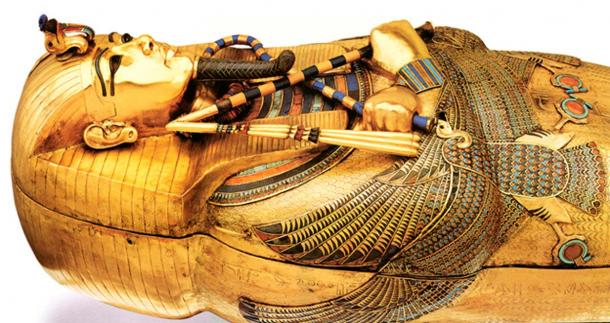
Tutankhamun’s golden coffin. ( Asaf Braverman / flickr )
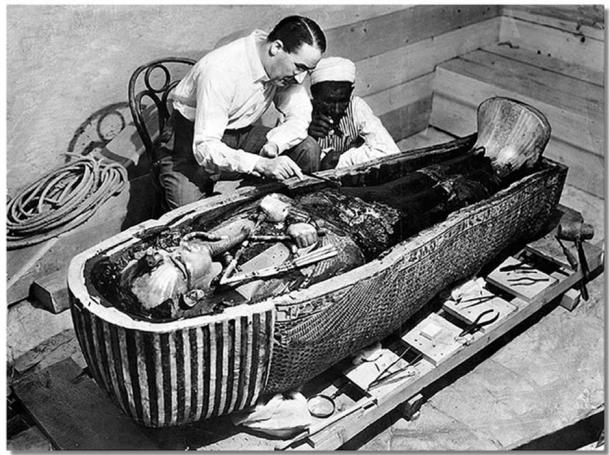
Howard Carter opens the innermost shrine of King Tutankhamen’s tomb near Luxor, Egypt. ( Public Domain )
In his diary, Carter wrote:
“The pins removed the lid was raised. The penultimate scene was disclosed – a very neatly wrapped mummy of the young king, with a golden mask of sad but tranquil expression, symbolizing Osiris. The similitude of the youthful Tut.Ankh.Amen, until now known only by name, amid that sepulchral silence, made us realize the past. By this bespangled mummy as it lies in the coffin, he must have been a tall youth – from the top of the headdress of the mask to the feet it measures 6 feet. Attached to the throat of the golden mask, beautifully wrought with juvenile countenance, are three massive gold & faience necklaces, a pendent heart-scarab placed between the hands, crossed over the breast, which hold the flail and the crook. Below this mask, which reaches as far as the hands, is the linen covering and outer bandages, strapped in place by broad longitudinal and transverse flexible bands of inlaid gold work depending from a highly decorative incrusted gold protective figure of Nekhbet. She has full spread wings reached across the body and a human head.” (Carter, 1925).
![]()
Detail of t he iconic Golden Mask of Pharaoh Tutankhamun. (CC BY 2.0 )
Thousands of Artifacts
In addition to the sarcophagus, the tomb contained many wonders to behold. Yet the treasures were in a great deal of disorder, perhaps because of the untimely death of the Pharaoh, everything was placed helter-skelter, seemingly without logic. There were six disassembled chariots and all manner of weapons, shields, and daggers – King Tutankhamen is said to have loved the hunt. There was also a wide array of furniture, much of it covered in gold: two royal thrones, couches, chairs, ritual beds, and headrests. There were chests containing priceless pieces of jewelry and beautiful clothing made of fine linen. There were jars containing rare perfumes, precious oils, and ointments. There were elaborate shrines to the gods, including one which hosted the Canopic jars that stored King Tut’s preserved internal organs. There were musical instruments and writing implements, lamps, ostrich fans, and board games. There was food and as many as 30 bottles of wine. There were also “139 ebony, ivory, silver, and gold walking sticks” (History Embalmed, 2016). In short, every conceivable thing a young king may need in the next life could be found surrounding his body and sealed shut for eternity in the tomb. Outside it all stood a magnificent life-size, gilded statue of the god Anubis, believed to be the lord of the underworld and protector of the dead.
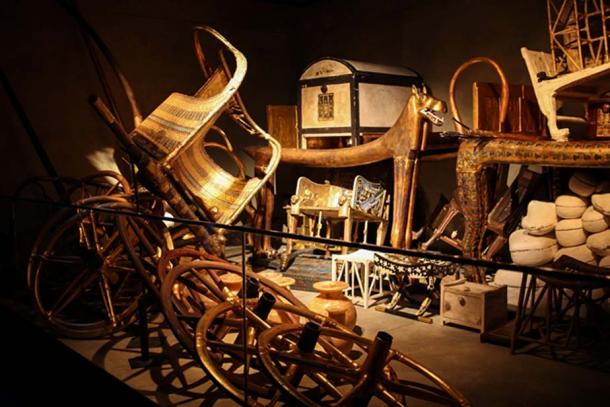
Just a small selection of the thousands of treasures found hastily stacked inside King Tut’s burial chamber. ( public domain )
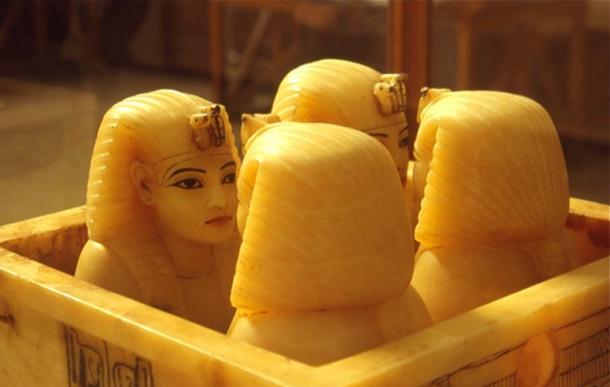
Canopic jars from Tutankhamun’s tomb.
Because of this discovery, Tutankhamen is one of the best-known Egyptian kings. His name is referenced is TV shows, movies, and video games ranging from the Three Stooges to Transformers. And thus, despite his enemies, King Tut has achieved eternal life.
Recently, Egyptologists have been reinvestigating Tutankhamen’s tomb. Experts believe that his small, seemingly second-rate burial may, in fact, have been a decoy to distract grave robbers from the real prize. “Radar scans on those walls [of Tut’s tomb] have revealed not only the presence of hidden chambers, but also unidentified objects that lie within these rooms. These objects…seem to be composed of both metal and organic materials” (Hessler, 2016).
The most popular theory? Concealed behind Tut’s tomb could be the long lost burial chamber of the magnificent Queen Nefertiti.
